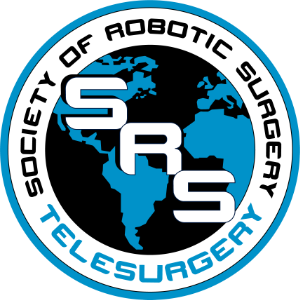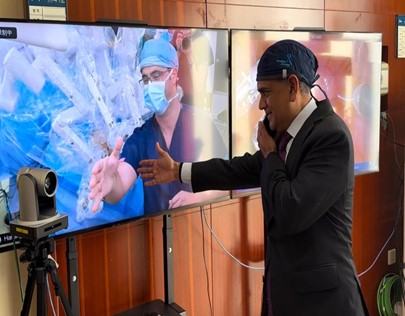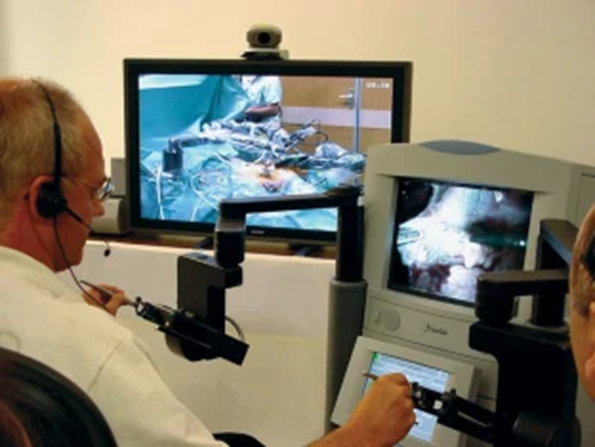Robotics, Telesurgery and Surgical AI Collaborative Community
Intro
Dr. Vipul Patel, Executive Director of the Society of Robotic Surgery (SRS) and Director of the Global Robotics Institute, along with many esteemed stakeholders in robotics and telesurgery, have come together to form a collaborative community. Enabled by advanced robotic systems and high-speed communication technologies, telesurgery involves the use of remote-controlled surgical instruments guided by a surgeon from a control station. Combining the precision of robotic technology and efficient, low latency tele-connectivity with the expertise of experienced surgeons, creates a bridge between geographical barriers and medical expertise.
Beyond geographical distances, remote surgery can also bridge temporal gaps, allowing surgeons to respond swiftly to emergencies or time-sensitive procedures. The reason to perform telesurgery is not to do it just because the technology allows it. The humanitarian, social and medical benefits are potentially enormous. The deficit in skilled surgeons in many rural or impoverished areas of the world is significant with many highly populated areas lacking skilled surgeons for critical procedures. Telesurgery is the natural solution allowing remote surgeons to assist local less experienced surgeons, when needed, or to fully perform the procedure remotely. As the robotic system landscape becomes more vast, integrating tele-surgical compatibility into the systems themselves will become essential, along with harnessing artificial intelligence to maximize its potential.
At the inaugural Telesurgery Congress in February 2024, many stakeholders from various industries and domains were present to discuss the journey towards realizing telesurgery. Experts from the fields of; medicine, surgery, surgical education, telecommunication, medical technology, government regulation, and hospital administration tackled many pertinent issues relating to the establishment of Telesurgery, the implementation of surgical AI, and the future of robotic surgery. A Delphi consensus was also launched during the conference with the results and conclusion to be published by June 2024. While addressing the pressing issue of global healthcare inequality, Dr. Patel stated, “Through technology and education, we, as experts, possess the capability to rebalance the scales.” In this scenario, the collaborative community, supported by the Society of Robotic Surgery, has been involved in several scientific articles, multi-specialty collaborations, and Telesurgery trials.
Vision & Purpose
This Collaborative Community aims to recommend best practices and robust strategies for addressing challenges in establishing remote surgery programs for equitable access to healthcare. One of the core foundations is generating and evaluating evidence that supports innovative approaches to remote surgical solutions while advocating patient rights and navigating the ethical, legal and regulatory conundrums that could arise. The community may also work to clarify ill-defined challenges or generate consensus on the definition and scope of the challenge that could be faced during launching and maintaining a functional remote surgery program.
Another core commitment the community will be advocating is establishing regulations and recommendations for the entry of robotic platforms into the commercial market and attempting to formulate and modify guidelines moving forward, adapting to patient needs and ensuring the safe and effective practice of robotic surgery.
Artificial intelligence is exponentially growing as a tool in healthcare and medicine and our role as stakeholders is to advocate for its correct use when providing for patients. The community will also attempt to play the role of a mediator between the AI community and healthcare and patients, fostering the notion of ‘Trustworthy AI’. Helping the general public understand the potential of AI in healthcare is part of our vision of improving patient outcomes.
By leveraging the wide variety of resources, skills and expertise of the community members, the Robotics, Telesurgery and Surgical AI Collaborative Community can help address challenges and create opportunities related to performing remote surgery on a national as well as an international scale and advance the field of medicine and surgery, taking it into the digital era.
Working Framework
Our working framework includes identifying challenges and opportunities, contacting stakeholders, engaging the ecosystem, and observing the impact. Integrating several specialties in the same project is crucial while developing and implementing new technologies in clinical practice.
.



